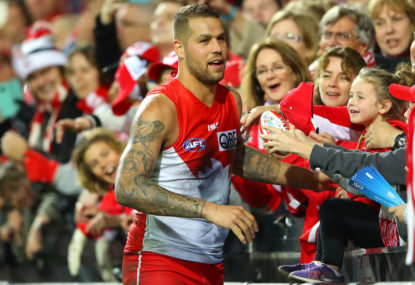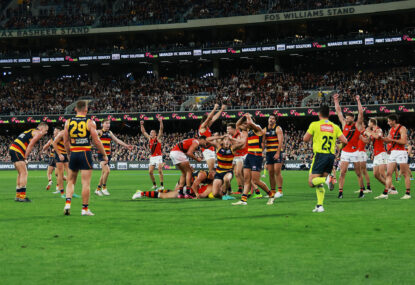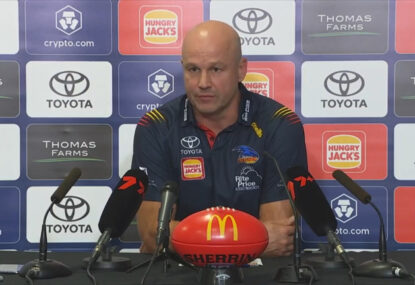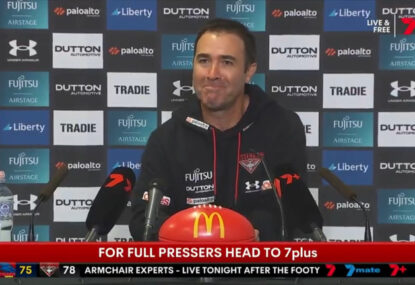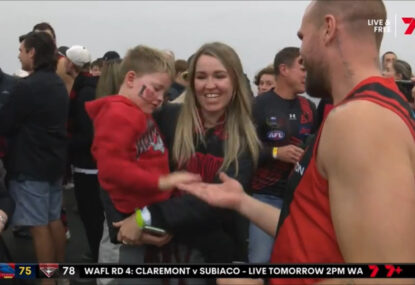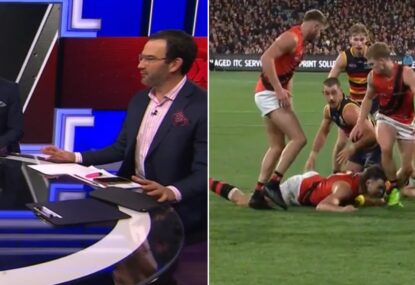It was in February of 2010 that then-AFL CEO Andrew Demetriou announced the league and players’ association had rubber-stamped the introduction of free agency to the player movement process.
“We believe this agreement is a positive outcome for players and the AFL competition,” Demetriou claimed at the time.
“The agreed model is fair for all concerned in that it gives players more flexibility but also contains safeguards that will help maintain the evenness of the competition.”
Five free agency periods have transpired since it was introduced at the end of the 2012 season and, while players have certainly had more flexibility, it’s hard to argue free agency has done much to maintain evenness.
Here, I’ve tabled every restricted and unrestricted free agency move since 2012. Delisted free agents weren’t included for the purpose of this exercise.
The tables list the player, the positions of the teams involved in the transaction that season, as well as whether free agent was in their former club’s best 22 that season.
2012 Free Agents
| Player |
Former club |
New club |
Best 22? |
| Shannon Byrnes |
Geelong (6) |
Melbourne (16) |
No |
| Troy Chaplin |
Port Adelaide (14) |
Richmond (12) |
Yes |
| Brendon Goddard |
St Kilda (9) |
Essendon (11) |
Yes |
| Chris Knights |
Adelaide (2) |
Richmond (12) |
No |
| Quinten Lynch |
West Coast (5) |
Collingwood (4) |
Yes |
| Brent Moloney |
Melbourne (16) |
Brisbane (13) |
Yes |
| Tom Murphy |
Hawthorn (1) |
Gold Coast (17) |
No |
| Danyle Pearce |
Port Adelaide (14) |
Fremantle (7) |
Yes |
| Jared Rivers |
Melbourne (16) |
Geelong (6) |
Yes |
| Clinton Young |
Hawthorn (1) |
Collingwood (4) |
Yes |
2013 Free Agents
| Player |
Former club |
New club |
Best 22? |
| Eddie Betts |
Carlton (8) |
Adelaide (11) |
Yes |
| Nick Dal Santo |
St Kilda (16) |
North Melbourne (10) |
Yes |
| Xavier Ellis |
Hawthorn (1) |
West Coast (13) |
No |
| Lance Franklin |
Hawthorn (1) |
Sydney (4) |
Yes |
| Colin Sylvia |
Melbourne (17) |
Fremantle (3) |
Yes |
| Dale Thomas |
Collingwood (6) |
Carlton (8) |
Injured |
| Matthew White |
Richmond (5) |
Port Adelaide (7) |
Yes |
2014 Free Agents
| Player |
Former club |
New club |
Best 22? |
| James Frawley |
Melbourne (17) |
Hawthorn (2) |
Yes |
| James Gwilt |
St Kilda (18) |
Essendon (7) |
Yes |
| Shaun Higgins |
Western Bulldogs (14) |
North Melbourne (6) |
Yes |
| Nick Malceski |
Sydney (1) |
Gold Coast (12) |
Yes |
| Jarrad Waite |
Carlton (13) |
North Melbourne (6) |
Yes |
2015 Free Agents
| Player |
Former club |
New club |
Best 22? |
| Matthew Leuenberger |
Brisbane (17) |
Essendon (15) |
No |
| Scott Selwood |
West Coast (2) |
Geelong (10) |
Injured |
| Dawson Simpson |
Geelong (10) |
GWS Giants (11) |
Yes |
| Matthew Sucking |
Hawthorn (3) |
Western Bulldogs (6) |
Yes |
2016 Free Agents
| Player |
Former club |
New club |
Best 22? |
| Nathan Brown |
Collingwood (12) |
St Kilda (9) |
Yes |
| Chris Mayne |
Fremantle (16) |
Collingwood (12) |
Yes |
| Tyrone Vickery |
Richmond (13) |
Hawthorn (3) |
Yes |
| Daniel Wells |
North Melbourne (8) |
Collingwood (12) |
Yes |
Overall, of the 30 restricted and unrestricted free agency moves, eight have seen a player from a top eight club dealt to a non-finals side, eight have gone the other way around, eight have taken place between two non-finals teams and six have been between fellow top eight sides.
At face value that sounds even enough, but when you start filtering by the player’s best 22 status, a different picture emerges.
All eight of the moves where a non-finals team has lost a player to a top eight side have involved a best 22 player. Jared Rivers and Danyle Pearce started the trend in 2012, with Colin Sylvia, Shaun Higgins, Jarrad Waite, James Frawley, James Gwilt and Ty Vickery following suit.
Granted, many of those moves haven’t panned out for the new club, but the James Frawley move was particulary bad.
A soon-to-be-elite key defender defecting from a bottom team to a two-time reigning premier isn’t particulary uncommon in the world of sport, but for a competition that prides itself on stringent evenness, it’s an indictment.
On the other side of the coin, only three of the eight players top eight sides have had pinched by bottom sides have been from their best 22.
Nick Malceski is probably the only example of the system ‘working’, with Eddie Betts’ defection to Adelaide driven largely by Carlton’s pursuit of Dale Thomas and Daniel Wells’ departure to Collingwood more a parting of the ways.
But neither Shannon Byrnes, Chris Knights, Tom Murphy nor Xavier Ellis were squeezed out of their clubs over salary cap concerns.
The fundamental issue in the AFL having free agency is that it’s players simply don’t earn enough money.
Yes, you read that right.
Of course, I’m not saying AFL players are underpaid for what they do. But on a global sports scale, there’s no denying that, as far as western domestic sporting competitions go, the salaries of AFL players dwarf in comparison to that of other competitions like the NFL.
With the completion of a new CBA for next season, the average player salary in the AFL will rise to $371,000 a year. The absolute minimum salary for an NFL player in their first season is $465,000USD – which works out to be almost $600,000 in Australian currency.
Where you could still probably count the number of AFL players earning $1 million a season on one hand, the top 100-paid players in the NFL have salaries ranging from $9-24 million.
[latest_videos_strip category=”afl” name=”AFL”]
So how or why is this relevant?
The issue isn’t that AFL players are ‘poor’ or anything of the sort.
The issue is that, because AFL salaries are comparatively low, lower teams simply cannot offer players financial terms significantly bigger enough to make them a go-to over a top team.
If you were an up-and-coming midfielder on $350,000 at a middle-of-the-road club like, say, St Kilda, would you accept an offer of $375,000 to play for Geelong or $450,000 to play for Brisbane?
Is the extra $75,000 enough to make you want to pack up, move interstate and play for a team that might only win five games? Maybe.
Changes Hawthorn’s figure to $11 million and Brisbane’s to $19 million and you might have a clearer idea.
With vastly bigger salaries comes a vastly bigger range of salaries. Because the earning capacity of NFL players is so high, the offers they can receive from different teams can also vary wildly.
At the end of the 2015 NFL season, the reigning champion Denver Broncos lost a whopping 14 free agents and gained zero. These kinds of exoduses are not at all uncommon among champion teams in the US.
The current two-time NHL champions Pittsburgh offloaded ten free agents this past offseason.
While we’ll never see this sheer degree of player movement in the AFL, the fact remains players at good teams don’t have enough financial incentive to head to clubs in the middle of a rebuild.
Some may call that club loyalty but, as far as free agency goes, it will continue to be a spanner in the works forever.





























































































